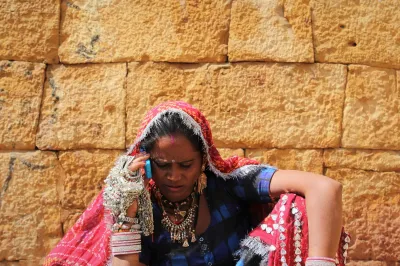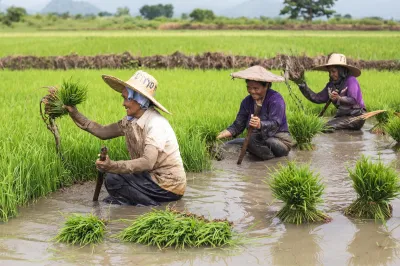Trickle Up Graduation Pilot Film on “The Test of Poverty”
New clothes. A new house. A child enrolled in a local school for the first time. Everyday images in many parts of the world, but a great change for a group of women in a village in India’s West Bengal whose path out of poverty is charted in a short film released this month by Trickle Up.
A new documentary entitled “The Test of Poverty,” which is partly-financed by CGAP, follows the progress out of poverty of two women out of 300 participating in the Trickle Up Ultra Poor Program, one of the nine pilots in the CGAP-Ford Foundation Graduation Program. This program is designed to help the very poor – those living on less than US1.25 a day – move out of extreme poverty. Indian filmmaker Gautam Bose directed the 18-minute film featuring the families of two West Bengal women, Samiran Bibi and Jamuna Sardar, and their successful path to greater self-sufficiency through the “Graduation” approach.
In January 2007, both families were living day-to-day, struggling to feed themselves more than once a day, or to clothe and educate their children. Through a process of community consultation, they were among the very poorest families in their village selected to receive assistance from the Trickle Up Ultra Poor Program: in Samiran’s case, it was goats and, for Jamuna, sheep and pigs. The film emphasizes that the donation of livestock is only the foundation for the graduation model, with proper training, temporary consumption support, access to savings, and regular “hand holding” from field staff providing critical support throughout the course of the program.
As the film shows, both women participated in self-help groups through which participants pooled their savings to create a collective fund that all could use for special needs. By the time of her “graduation” in October 2009, Samiran Bibi’s efforts with goats and rice farming had translated into three meals a day, a new house, and an embroidery business that she started with her husband. Jamuna Sardar tells of building a new toilet in her home, new clothes for her family, and enrollment in school for her son. Trickle Up plans to build upon the success of women such as Samiran and Jamuna by expanding its reach to 5,000 people in the poorest parts of India.
Trickle Up has posted the documentary on its Website at www.trickleup.org and a shorter version of the film is also to be found on YouTube.




Comments
Interesting that although
Interesting that although this is described as being evaluated with randomised controls on the CGAP website – Trickle-Up only discuss before-after comparisons of their participants.
What is real micro finance ?
What is real micro finance ?
CGAP’s commendable work towards poverty reduction is ‘graduated trickle up approach’ with the focus on the ‘poorest’ although there is some hesitation for CGAP to represent ‘P’ in the acronym CGAP for poorest. However, a glance at the trickle up graduation documentary film reveals the real and ideal micro finance forewarning many things for a candid achievement of the ultimate goal of micro finance – ‘Poverty reduction’ yes ‘poverty alleviation’ too. The above experiments no doubt, I feel, throw some of tenets to be followed closely to see the light at the end of the tunnel in the so called much romanticized micro finance game
First, the target group need to confine to ultra poor or the poorest among the poor community – identification through community mapping/wealth ranking . collective (group)approach for mutual benefit
Second, ,Trickle up / graduated approach from the bottom of poverty pyramid. with social intervention based on the capacity and the needs of the poorest
Third, mat and micro metal box banking is the real micro finance institution at grass root level . This indigenized informal entity requires a small metal box (for keeping the money for transaction) , a mat ( for sitting) and a few note books(for recording the transaction) as one could view in one of the trickle up film documents (Guatemala) where one poor women carries the above things in her hands with her child at her back tied up with some pieces clothes along with her.body.
Fourth sequencing the micro finance inputs supported with non financial component – capacity building of the poorest to cope up the vulnerability and micro credit risk . Here basic social services need to be preceded to micro credit services .(Putting the last first is suicidal .as it happens now in the MFI system)
Fifth,, partnership with public and private sector to arrange needed ‘safety net’ inputs for the poorest such as – Public Distribution System for food grains, women welfare programe including for pregnant women , integrated child welfare programe, free premium micro insurance , hut insurance , livestock insurance , free schooling with nutrition food, For improving access to these safety nets , the target group need to be empowered for their entitlement ( CGAP need to focus more on improvement in access to micro insurance for the target group in these pilot projects along with other MF services.)
Sixth local savings and credit group system need to be strengthened and encouraged with local money and not necessarily with external money although it is claimed micro finance
Seventh, sustainable livelihood programe is to start with what the type of assets the poorest have in their environment
In fine, while these types of grass root informal (social capital) institutions like SHGs, democratically managed with their own capital facilitate for making a sustainable dent in poverty canvas, this becomes real micro finance in true sense of the term without a need for a) regulation& ordinance (to protect the poor from usurious interest rate, rigid recovery measures and suicides) and b) global micro credit summit rituals for celebrating money lending activities. In the longer run pseudo Microfinance activities ( confining to micro credit lending and moving for non poor targeting) need to be gradually eschewed and replaced by the locally managed MF system for garduation of the poorest through SHG in the process of poverty reduction and candid achievement of MDGs. .
I am a Rural Management
I am a Rural Management student from Xavier management of Management, Bhubaneswar (XIMB), India. During the “Rural management” course I regularly come across many NGOs who are working on different problems of Rural sociey. It’s my job here to study & analyze their work. I have seen the works of many NGOs even when I was working with BASIX (www.basixindia.com) in Bihar before joining the Rural Management course here. I must say the way the “Trickle Up” program has helped in improving the life and livelihoods of the villagers is extraordinary & unmatched. The video explicitly shows the some of the Social assessment methods like PRA & wealth ranking. ‘Trickle up” up has chosen very carefully the important sectors like Livelihood, Health & Sanitation, Animal Health (Goat’s tumor) , Agriculture (SRI) & housing to work upon. A highly appreciable effort & a well documented movie to show the effects. Kudos to you..!!
Add new comment